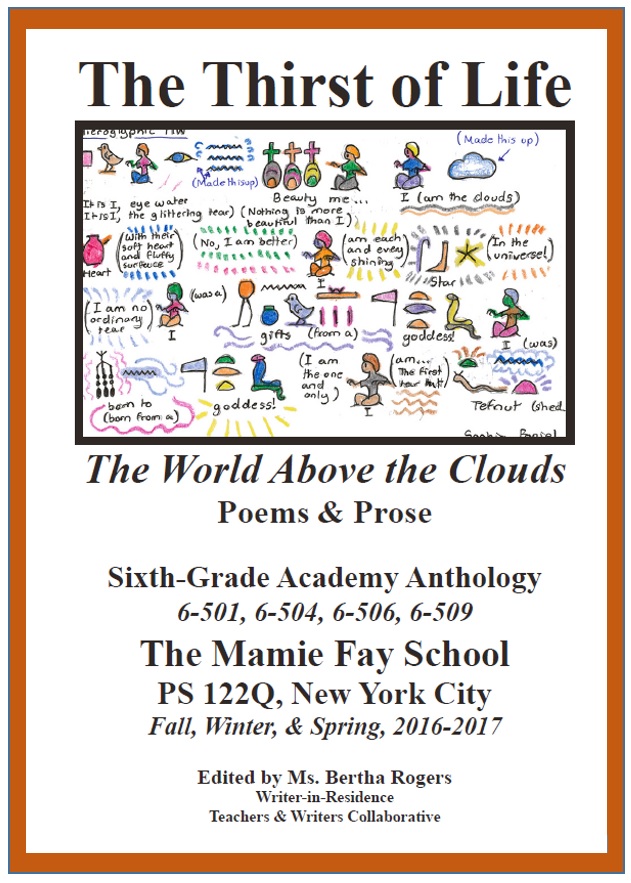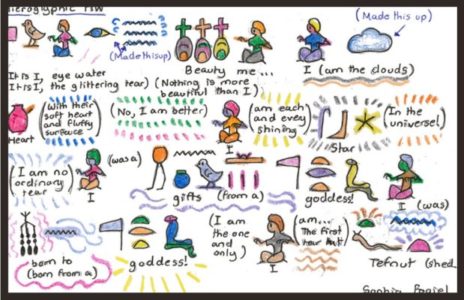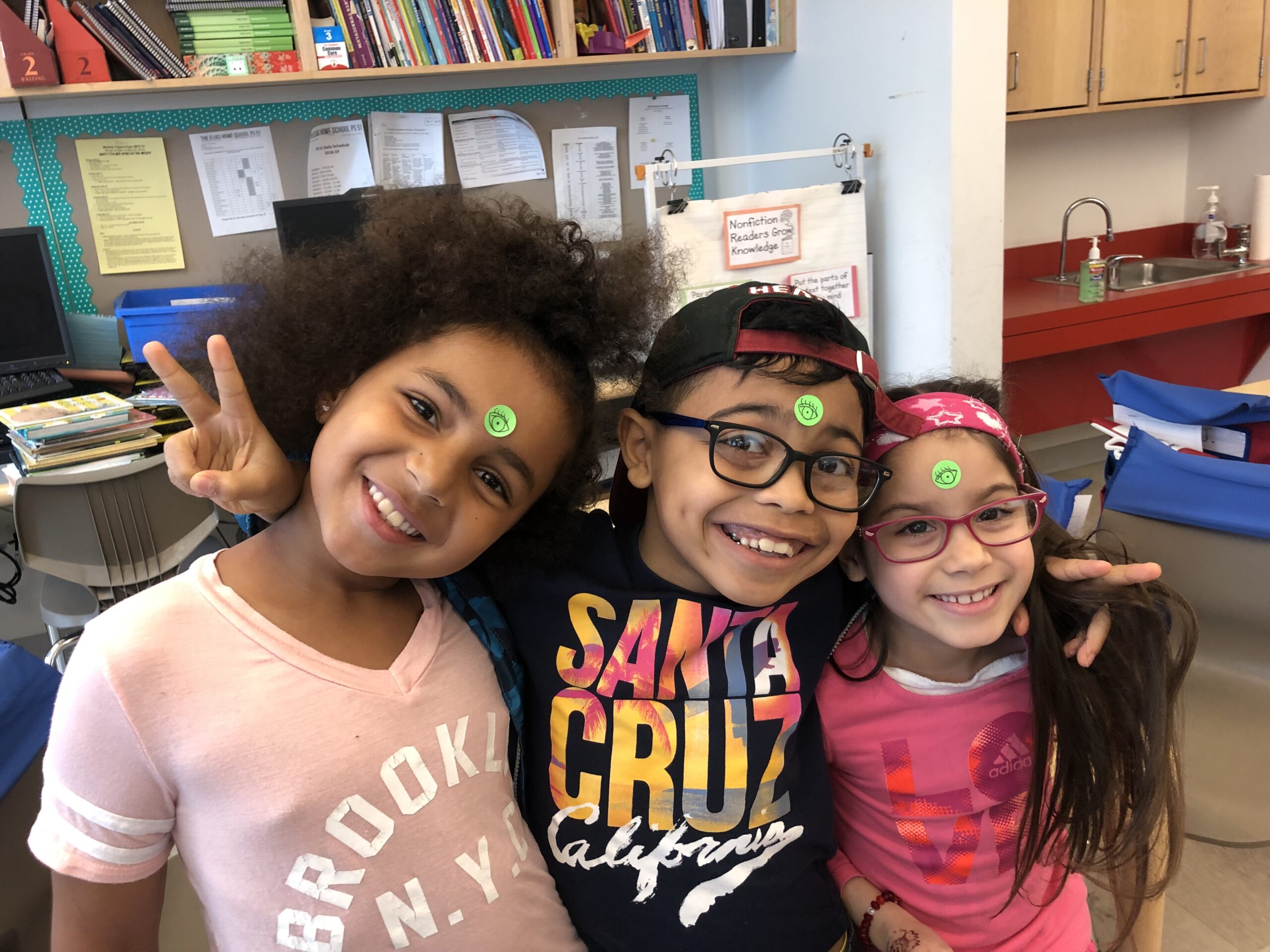From the introduction to The Thirst of Life, anthology for the writing residency at 122Q.
This school year, 2016-2017, has been my 16th season of teaching creative writing at PS 122Q, the Mamie Fay School, in Astoria, Queens, New York. It has, once again, been my distinct privilege and pleasure to teach the wonderful 6th-graders at this fine school, to work with their innovative teachers, and to be the lucky recipient of their knowledge and support. I’m proud to say that we together have developed a comprehensive program of creative writing that incorporates social studies, world history, and geography as well.
The Mamie Fay School is a Gifted and Talented Magnet School, drawing students who are excited by challenge, who want to try new things, who are eager to share what they’ve learned with each other. PS 122Q is culturally diverse, with students from everywhere in the world, making it a true melting pot, a place where students can learn from each other and interact without noticing the color of their skin, their accents, their past.
Such a climate is more than stimulating for the teaching artist; it is a daily challenge, and the benefits are many. The reader will grasp the truth of this as she turns the pages and delights in each new discovery.
These students were studying the civilizations of Ancient Mesopotamia, Greece, Egypt, and Africa. They were learning what the peoples of these cultures learned. They read the ancient legends and developed their own and, in the process, learned how legends were developed, how important it was and is for people to grasp where they are, not just in place, but in time. They wrote personification poems about the gods or about the longest river in the world, the Nile. They studied hieroglyphs and added them to their poems, making their own illuminated manuscripts. Working in this manner aids the students in understanding the daily lives of these peoples and in developing that most important emotion for any thoughtful person, empathy.
On two cold winter days, we piled into school buses and traveled to that repository of beauty and learning, the Metropolitan Museum of Art. The students drew and took notes and learned new facts about their school studies. I always ask them to learn from three-five things they hadn’t known about their topic and then write that new information into their poems and stories.
When we came back to school, the boys and girls wrote Ekphrastic poems and stories about the art and historical objects they’d seen because looking is the first step toward really “seeing,” and because that first step leads to precise and elegant expression in language. Most of these writings were in the Japanese Haibun style, a style that enables them to carefully look and write about the art, then close their thoughts with Haiku.
Because these students have a wide world view, we don’t limit ourselves to writing in forms that are traditional to American schools. We write Korean Sijos, Italian Sestinas, French-Italian Villanelles, Malaysian Pantoums, French Rondeaus, Russian Sevenlings, Italian Fibonaccis, English Sonnets, Chilean Odes (after Pablo Neruda), Anglo-Saxon Riddles, Greek Anacreontic Rhymes, and more. We write personification poems and creation legends. We write open-form poems, too.
We try everything because there is so much available to us and because we know that the more we try, the more we “own.” We live in a time when there is more available to us than ever before. We can read the great poets, ancient and contemporary, in books or on the Internet; we can use the Internet like the encyclopedia it is to expand our knowledge and understanding.
Some of the poets we read and studied included Elizabeth Bishop, American poet; Marianne Moore, American poet; Donald Justice, American poet; Pablo Neruda, Chilean poet; William Shakespeare, English poet and playwright; W. H. Auden, English-American poet; Walt Whitman, American poet; Emily Dickinson, American poet; Marilyn Hacker, American poet; W. S. Merwin, American poet; Rabindranath Tagore, Bangladesh poet; Basho, Japanese poet; Tu Fu, Japanese poet; Federico Garcia Lorca, Spanish poet; Rainer Maria Rilke, German-Austrian poet; Anna Akhmatova, Russian poet; Christina Rossetti, English poet; Anacreon, Greek poet; William Carlos Williams, American poet; and others.
We learned how to make miniature artist books, i.e., the Throw-out, the Starburst, the Pocket Accordion, and the Flexagon; and we wrote our poems in the artist books and displayed them on the hall bulletin board.
The students accomplished a great deal during our 20 sessions together; and none of their accomplishments would have been possible without the beautiful collaboration from Ms. Pappas and Ms. Garanes; and without the help of the 6th-grade teachers as we traveled to the Met.
This residency wouldn’t have been possible without the dedicated administrators and staff of PS 122Q; I especially thank Ms. Pamela Sobel, Principal, for her wise and patient guidance. Finally, this residency wouldn’t have happened without these bright and lively students. I wish them all a life of looking, seeing, and writing it all down!
Bertha Rogers
June 2017




